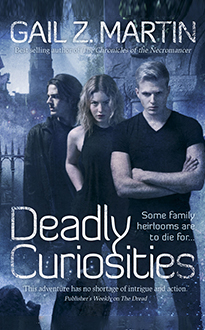by Gail Z. Martin
How do you know where your story begins?
Doesn’t it begin at, well, the beginning?
Not necessarily—at least, not that the reader needs to know.
My new book, Ice Forged, begins with a murder. It’s important for readers to see the murder occur so that they understand my main character, who commits the murder and is sent into exile. Chapter two picks up six years later.
Why? Because nothing else relevant happens to the plot happens until then.
Couldn’t I have just begun the book with Chapter 2 and done a flashback? Perhaps. But by beginning the book where I did, the reader gains an understanding of the main character that I don’t think would have been as strong had it been recounted through a flashback or a dream or by having someone just tell about it.
I faced a similar challenge in another book, where the action in the first chapter occurs immediately after the end of the previous book. My hero is pinned down in a battle. On my first draft, I had them take cover in a barn. When I re-read the draft, I realized that having the book open with my hero hiding in a barn didn’t seem very, well, heroic. So I jumped the action ahead to a few moments later, when he actively engages in the fight.
What’s the right place to begin a story? That depends. It depends on the reaction you want your reader to have as they read the beginning. It also depends on where the meat of your story arc takes place.
Here’s the most important thing: Your beginning absolutely MUST grab the reader so hard with the first sentence, first paragraph and first page and he or she cannot set the book aside.
Agents and editors reading over a manuscript will only go on to page two if your first page has grabbed them. Readers flipping through your book in a store or on line are just as particular. You don’t have time to take dozens of pages setting the scene. You’ve got to score a knock-out punch on page one.
I’ve done a lot of manuscript analysis for a book shepherd in California, and one of the most frequent issues I find in not-yet-published books is a slow beginning. One book took more than 30 pages for the main character just to get out of bed! If you find yourself with a slow beginning, ask yourself where the real action begins and try starting the book there.
Yes, you the author need to know all the other details. But you don’t have to share them with the reader. Remember, you’ve only got one sentence, one paragraph, one page to turn a browser into a buyer. Grab ‘em by the lapels and give them a good shake so that they can’t stop turning the pages!
Gail Z. Martin’s newest book, Ice Forged: Book One in the Ascendant Kingdoms Saga (Orbit Books), launched in January 2013. Gail is also the author of the Chronicles of the Necromancer series (Solaris Books) and The Fallen Kings Cycle (Orbit Books). For more about Gail’s books and short stories, visit www.AscendantKingdoms.com. Be sure to “like” Gail’s Winter Kingdoms Facebook page, follow her on Twitter @GailZMartin, and join her for frequent discussions on Goodreads.
Read an excerpt from Ice Forged here: https://a.pgtb.me/JvGzTt











